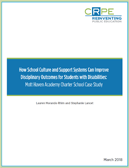CRPE contracted with the National Center for Special Education in Charter Schools (NCSECS) to conduct case studies on school models and practices that effectively serve students with special needs. This brief highlights how a New York City charter school is using a positive, inclusive environment and restorative discipline practices to improve outcomes for students with disabilities.
About Mott Haven Academy and Its students
Mott Haven Academy is an independent charter public school in New York City serving pre-K through 6th grade. It is the first school in the nation designed explicitly to focus on the specific needs of children in the child welfare system; 49 percent of its students are in the foster care system or considered at risk of placement in foster care. Haven Academy provides wraparound services to its families through partnerships with several child welfare agencies and community-based organizations that provide housing, medical, and mental health supports.
What makes Haven Academy’s school culture and behavior supports work well for students with special needs?
Key aspects of the academy’s model include the following:
- Admissions and enrollment processes proactively include and support student populations at risk of being marginalized, including students with disabilities.
- Teachers and school leaders address behavior with methods tailored to individual students, which preemptively deter behavioral issues and incorporate opportunities for intentional reflection and growth.
- The school culture and behavior supports are infused with social-emotional learning and address individual needs of students as shaped by their lives beyond the classroom.
- Students learn in a restorative environment that is safe, stable, structured, and understanding, particularly benefiting students with disabilities by fostering full inclusion.
NCSECS researchers conducted document reviews of both publicly available and privately shared resources; interviewed school administrators, teachers and staff, students, and families; and observed educators and students in action. The case study reflects school information from the 2017-2018 school year.





